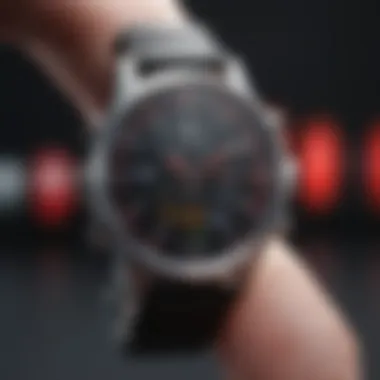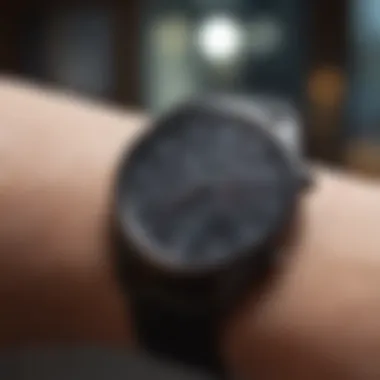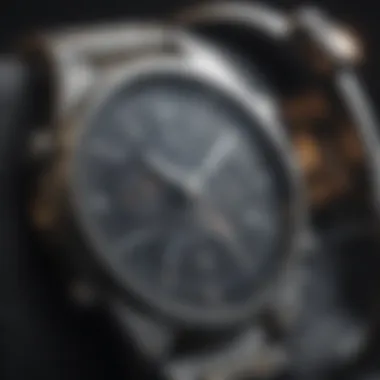Understanding Oxygen Level Monitoring in Smartwatches


Intro
The landscape of health monitoring has changed significantly with the advent of wearable technology, particularly smartwatches. These small devices offer various functionalities, one of the most noteworthy being the ability to monitor blood oxygen levels, known as oxygen saturation. This capability is critical, as oxygen is essential for cellular processes in the body. Understanding how smartwatches measure oxygen levels can illuminate their impact on personal health and clinical practices.
Health monitoring through smartwatches allows users to gather valuable data about their physiological states. This information can serve a variety of purposes, from physical training to chronic condition management. However, the incorporation of this technology comes with its complexities, including the accuracy of readings and real-world applications.
This article aims to provide a thorough exploration of the technology behind blood oxygen monitoring in smartwatches. It will examine the physiological significance of oxygen saturation, the technological mechanisms used in these devices, and the potential applications and limitations present in both personal and clinical settings.
Preamble to Oxygen Levels Monitoring
Monitoring oxygen levels in the blood has gained significant attention in recent years. This is mainly due to the growing prevalence of chronic respiratory and cardiovascular diseases. Smartwatches designed to track oxygen saturation levels have emerged as key tools in personal health management. The ability to monitor one’s oxygen levels can provide useful insights into overall health and well-being.
Definition of Oxygen Saturation
Oxygen saturation refers to the percentage of oxygen in the blood that is bound to hemoglobin. A healthy individual typically has an oxygen saturation level of 95% to 100%. When oxygen saturation dips below this range, it can signify potential health issues. Understanding this measurement is important for early detection of conditions such as hypoxia.
Importance of Monitoring Oxygen Levels
Monitoring oxygen levels can help individuals recognize changes in their health status. Early detection of low oxygen levels can lead to timely medical intervention. Here are some reasons why monitoring is valuable:
- Prevention of Health Complications: Regular tracking can prevent further health deterioration by allowing for prompt treatment.
- Awareness of Physical Status: Athletes may use this information to gauge their performance and stamina during training.
- Management of Chronic Conditions: Patients with existing respiratory problems can benefit from continuous monitoring and adjustments to their treatment plans.
"The significance of oxygen monitoring is underscored by its role in promoting proactive health measures."
Incorporating smartwatches into everyday health routines provides a convenient means of tracking personal health metrics. Thus, understanding oxygen level monitoring is critical in the evolving landscape of health technology.
Technological Advancements in Wearables
The domain of wearable technology has seen significant growth, particularly in the monitoring of various health metrics. In this context, advancing technology in wearables, specifically related to oxygen monitoring, holds profound importance. Wearable devices have become crucial tools for both personal health management and clinical settings. They provide real-time data that can be essential for early detection and monitoring of various health conditions.
A key aspect of these advancements is the integration of sophisticated sensors and algorithms. This combination enhances the accuracy and reliability of measurements, allowing users to make informed decisions about their health. Moreover, the continuous improvements in battery life and miniaturization of components enable wearables to be more user-friendly and accessible.
Additionally, the advancement of connectivity options, such as Bluetooth and Wi-Fi, allows wearables to sync data with smartphones and other devices seamlessly. This ecosystem of connected devices can empower users to track their oxygen levels over time, providing valuable insights into their health.
In summary, the technological advancements in wearables not only enhance the capabilities of oxygen monitoring devices but also contribute to a more informed and health-conscious society. The following sections will delve deeper into the rich history and evolution that have brought wearable technology to its current state.
History of Wearable Technology
The concept of wearable technology is not as recent as many believe. The origin can be traced back to the 1960s when the first wearable computers emerged. These early devices were primarily used by researchers and the military. They often included bulky components and offered limited functionality.
By the 1980s, technology began evolving with humble prototypes like the calculator wristwatch, which brought computing power to the wrist of consumers. However, the real transformation began in the 21st century due to advancements in microelectronics and battery technology. This evolution facilitated more sophisticated prototypes that eventually led to the smartwatches we see today.
The growth of the internet and mobile technology has also played a vital role. With increased connectivity, wearables could transmit data seamlessly, paving the way for health monitoring applications.
"Wearable technology has transitioned from experimental military tools to everyday health companions, reflecting significant advancements in both technology and user needs."
Evolution of Smartwatches
Smartwatches represent the pinnacle of wearable technology. Initially, they were simple devices that offered timekeeping and basic notifications. However, their purpose has dramatically shifted over the years.
Today's smartwatches encompass numerous functions beyond mere time display. Key features include:


- Fitness Tracking: Most smartwatches now track physical activity and heart rate.
- Health Monitoring: Advanced models measure oxygen saturation, sleep patterns, and even ECG.
- Connectivity: Users can receive calls and messages without needing their smartphones nearby.
- Customizable User Experience: With various applications available, users can personalize their devices to suit their specific needs.
The medical applicability of smartwatches continues to expand. Features such as continuous oxygen monitoring have been integrated, making them valuable tools not just for fitness enthusiasts but for those managing chronic conditions. This shift illustrates the growing integration between technology and healthcare, providing users with more control over their health.
Mechanisms of Oxygen Level Measurement
Understanding how oxygen levels are measured is central to evaluating the technologies used in modern smartwatches. These mechanisms not only provide critical data but also contribute to the reliability and effectiveness of wearable health devices.
Oxygen level measurement is fundamentally about capturing how much oxygen is present in the blood. Accurate tracking of this measurement is essential for various applications, from personal health monitoring to athletic performance and clinical diagnostics. The ability to assess oxygen saturation (SpO2) effectively enables users to respond to health issues that might otherwise go unnoticed.
Photoplethysmography (PPG)
Photoplethysmography (PPG) is a non-invasive optical technique for measuring changes in blood volume. It employs a light source and a photodetector to collect data from the skin's surface. Different wavelengths of light are used, typically infrared and red light, to penetrate the skin and reach the blood vessels. The core principle lies in how oxygenated and deoxygenated blood absorbs light differently.
Key Considerations of PPG:
- Simplicity and Cost-Effectiveness: PPG systems are often more affordable, making them more accessible for consumers.
- Real-Time Monitoring: The technology allows continuous monitoring, which is crucial for athletic training and health tracking.
- Limitations: Factors such as skin tone, movement, and ambient light can influence accuracy. Users must be aware of these limitations to ensure proper functionality.
"PPG provides a window into the cardiovascular system, allowing insights that extend beyond simple oxygen measurements."
Pulse Oximetry Technology
Pulse oximetry is another critical technology for measuring oxygen level. Like PPG, it is a non-invasive method but focuses specifically on estimating the oxygen saturation of the blood. This is achieved by using a clip-like device placed on a finger, toe, or earlobe. The pulse oximeter works by shining light through the tissue and measuring the light that passes through to determine the color of the blood.
Main Features of Pulse Oximetry:
- Precision: Pulse oximeters are recognized for their clinical reliability, offering accurate assessments of oxygen saturation.
- Widespread Use: Commonly employed in medical settings, these devices can be adapted for consumer use, especially in watches.
- Cautions: Similar to PPG, pulse oximetry can be affected by factors such as poor circulation, nail polish on fingers, or high altitude, which may distort readings.
Understanding these mechanisms equips users with the knowledge to select appropriate devices for monitoring oxygen levels. Both PPG and pulse oximetry present valuable insights into the physiological state of the individual, but each comes with its own set of strengths and limitations.
Biological Basis of Oxygen Saturation Monitoring
Understanding oxygen saturation monitoring requires a grasp of its biological underpinnings. Oxygen is critical for cellular function and overall health. When oxygen saturation levels drop, the body's physiological balance is disrupted, leading to various health issues. Monitoring these levels is not only beneficial but essential in many scenarios.
Oxygen saturation indicates the percentage of hemoglobin that is saturated with oxygen in the blood. Generally, healthy individuals maintain oxygen saturation levels between 95% to 100%. Below this range, particularly under 90%, there can be significant health risks. Understanding this relationship between oxygen saturation and health is vital, especially in aging populations or those with chronic health conditions.
How Oxygen Saturation Affects Health
Oxygen saturation plays a fundamental role in physical well-being. It affects cognitive function, physical endurance, and the body's ability to recover from illness or exertion. Low levels of oxygen can result in symptoms like shortness of breath, confusion, and fatigue. In severe cases, hypoxia — a condition that arises when oxygen levels are insufficient — can lead to organ damage or failure.
Various health conditions can cause low oxygen saturation:
- Chronic obstructive pulmonary disease (COPD): This lung condition limits airflow and reduces oxygen levels.
- Pneumonia: Inflammation in the lungs can obstruct the exchange of oxygen.
- Heart failure: This condition can impede the heart's capability to pump sufficient blood to meet the needs of the body.
Regular monitoring can provide insights into these conditions, enabling timely interventions. For this reason, maintaining optimal oxygen saturation is directly linked to improving quality of life.
Physiological Mechanisms of Oxygen Transport
Understanding how oxygen is transported throughout the body can illuminate the importance of monitoring this vital sign. Once inhaled, oxygen travels through the lungs to the alveoli, where it diffuses into the blood. Here, it binds to hemoglobin molecules within red blood cells. These cells then transport oxygen to tissues and organs.
Various factors influence this transport process:
- Hemoglobin levels: A lower amount of hemoglobin can decrease the transport capacity for oxygen.
- Blood flow: Circulation efficiency is critical for oxygen delivery. Poor circulation can hinder oxygen transport even if saturation levels appear adequate.
- Altitude: At higher elevations, the partial pressure of oxygen decreases, which can lead to lower saturation levels in the blood.


The body also has mechanisms in place to adapt to varying levels of oxygen. For instance, during physical exertion, the body increases heart rate and blood flow to enhance oxygen delivery. However, monitoring these changes is crucial to prevent health complications.
"The capacity for oxygen transport and its saturation in blood is essential for life. Monitoring this can save lives."
In sum, a profound understanding of the biological basis of oxygen saturation monitoring reveals its significance for health. It establishes a direct connection between oxygenation levels and overall wellness, thus underscoring the need for effective monitoring technology.
Applications of Oxygen Monitoring Watches
Oxygen monitoring watches serve multiple purposes, providing valuable data that can enhance individual health and performance. In this section, we explore three main applications: personal health management, athletic performance monitoring, and clinical applications. Understanding these applications is key for maximizing the benefits of these devices in both everyday life and specialized fields.
Personal Health Management
Personal health management involves daily monitoring of one's well-being. Oxygen monitoring watches can help users track their oxygen saturation levels over time, providing insights into their respiratory health. Individuals suffering from conditions such as asthma or chronic obstructive pulmonary disease (COPD) can benefit significantly from continuous monitoring. By regularly checking oxygen levels, these users can make informed decisions regarding their health, such as when to seek medical attention or adjust their activity levels.
The data collected can easily be shared with healthcare professionals. This ongoing dialogue allows for personalized treatment plans based on actual measurements rather than hypothetical symptoms. Not only does this promote better chronic disease management, but it also encourages users to take an active role in their health.
Athletic Performance Monitoring
In the realm of sports, oxygen monitoring watches provide athletes with essential information about their performance capabilities. Understanding oxygen saturation during physical exertion can highlight endurance levels and recovery times. A high level of oxygen saturation typically correlates with better performance, while fluctuations might indicate areas for improvement.
For athletes training at high altitudes, where oxygen levels are typically lower, these devices play an important role. They allow athletes to monitor their body’s response to altitude exposure, ensuring they adapt effectively. Furthermore, understanding oxygen consumption can aid in the optimization of training regimens, enabling athletes to push their limits safely.
Clinical Applications
Oxygen monitoring watches also hold significant potential in clinical settings. They provide a non-invasive way to track patients' oxygen levels continuously. This is particularly valuable for hospital settings, where monitoring can be critical for post-operative patients or those with respiratory issues.
In emergencies, the ability to quickly assess oxygen saturation can guide immediate treatment decisions. For long-term care facilities, these devices help in recognizing deteriorations in patient conditions before they become serious. By integrating oxygen monitoring into patient care, healthcare providers can deliver timely interventions, ultimately aiming to improve patient outcomes.
"The smart integration of technology in monitoring will redefine personal and clinical health management practices."
Consolidating oxygen level data across these applications can lead to an innovative approach to health management. As technology advances, the potential for monitoring devices to foster better health decisions and results will grow, showcasing their invaluable contributions to both personal health and clinical settings.
Limitations of Current Technology
Understanding the limitations of current technology in oxygen level monitoring is crucial for recognizing the efficacy and reliability of wearable devices. While advances in smartwatches and fitness trackers have made oxygen monitoring more accessible, there are certain inherent flaws that users and healthcare professionals must consider. These limitations can impact the accuracy of collected data, user experience, and overall health outcomes.
Accuracy of Measurements
One significant limitation of current oxygen monitoring technology is the accuracy of measurements. Photoplethysmography (PPG), the primary method used for capturing oxygen saturation levels, is not always reliable. Factors such as skin tone, ambient light interference, and even motion can affect the readings. Research has shown that darker skin tones may yield less accurate results, leading to potential misinterpretations of an individual’s oxygen levels.
Additionally, environmental conditions play a role in measurement accuracy. For example, high altitudes can cause physiological changes that may not be accounted for by the smartwatch’s algorithms, resulting in misleading data. Users need to be aware that while Wearable technology provides a convenient means to monitor health, they should not entirely rely on these readings without further verification from a medical professional. Therefore, ensuring accuracy and contextualizing readings is critical in avoiding misdiagnosis or undue alarm.
Inaccurate readings can lead to improper health assessments, underscoring the need for enhanced calibration and validation of wearable devices.
User Compliance and Education
Another limitation is the issue of user compliance and education. Users may not have a complete understanding of how to properly use these devices for monitoring oxygen levels. Misunderstanding the device’s functionalities can lead to incorrect readings or inadequate response to readings that indicate potential health issues. For instance, if users do not know how to interpret low oxygen saturation levels, they may neglect seeking medical advice in critical situations.
Education is also essential in explaining the necessity of regular monitoring and the impact of external factors on readings. Many users may not utilize the technology to its full potential due to a lack of comprehension about the importance of ongoing tracking and evaluation.
In summary, while oxygen level monitoring through wearable devices offers significant advantages, acknowledging the limitations surrounding accuracy and user compliance is vital. Addressing these issues through education and advances in technology can enhance the effectiveness of oxygen monitoring in smartwatches and improve health outcomes for users.
Future Trends in Oxygen Monitoring Technology


The landscape of oxygen monitoring is evolving, driven by rapid technological advancements and a growing demand for holistic health insights. This section delves into the emerging trends that are shaping the future of oxygen level monitoring technology, with a focus on how these advancements can enhance personal health management and clinical practices.
Integration with Other Health Metrics
One significant trend is the integration of oxygen monitoring with other health metrics. Modern smartwatches are not just measuring blood oxygen saturation; they are also tracking heart rate, stress levels, sleep patterns, and physical activity. This convergence provides a more comprehensive view of an individual’s health.
- Holistic Health Insights: By combining oxygen levels with other vital signs, users can gain insights into their overall well-being. For example, low oxygen levels coupled with a high heart rate may indicate a respiratory issue or strenuous activity.
- Data-Driven Decisions: Such integration enables users to make informed decisions about their health. For instance, those with chronic conditions can adjust their medication based on real-time feedback from their devices.
- Enhanced User Experience: The ability to monitor various health parameters in one device streamlines the user experience. Instead of switching between different apps or devices, users find convenience in having aggregated data at their fingertips.
Advancements in Sensor Technology
Sensor technology is another pivotal area of development in oxygen monitoring. Advances in materials science and microelectronics enable the creation of smaller, more accurate sensors. These innovations often lead to better performance and enhanced user satisfaction.
- Miniaturization of Sensors: As sensors become smaller, integrating them into wearables becomes easier without compromising comfort or aesthetics. This miniaturization allows for more versatile designs and broader adoption of monitoring devices in everyday life.
- Improved Accuracy and Reliability: Latest sensor technologies utilize new algorithms and advanced signal processing techniques. This results in increased accuracy in oxygen saturation readings. High reliability is crucial, especially for users with health conditions requiring precise monitoring.
- Longer Battery Life: Continuing advancements also contribute to battery efficiency, allowing devices to operate longer without frequent recharges. This is essential for continuous monitoring, which is particularly beneficial in clinical settings.
"The integration of diverse health metrics and the evolution of sensor technology stand to redefine how we manage health in a proactive manner."
The trajectory of oxygen monitoring technology is steeped in integration and innovation, turning devices into sophisticated health management tools. As the landscape continues to evolve, staying informed about these trends will be crucial for users aiming to optimize their health outcomes.
Comparative Analysis of Available Devices
The comparative analysis of available devices is essential in understanding the diverse options in the market for oxygen level monitoring technology. This section sheds light on the distinctions between various devices and offers insights into their capabilities, which is crucial for both consumers and professionals alike. By evaluating these devices, users can make informed choices based on performance, accuracy, and cost-effectiveness.
Consumer Market Overview
The consumer market for wearable technology that monitors oxygen levels has experienced significant growth in recent years. Many companies have entered this space, providing a wide array of options that cater to different user needs. Popular brands like Apple, Samsung, and Garmin have incorporated pulse oximetry into their smartwatches, attracting a diverse user base.
These devices typically target consumers interested in personal health management and fitness monitoring. They come equipped with features like heart rate tracking and sleep analysis, ensuring a comprehensive overview of one's health metrics. However, it is crucial to recognize the trade-offs. Some devices may excel in user-friendly designs while lacking in measurement accuracy. Others may offer advanced features but at a higher price point.
When assessing the consumer market, the following factors emerge as significant:
- Price Range: Consumer smartwatches can vary widely from budget-friendly options to high-end devices full of features.
- Brand Reputation: Established brands may offer reliability but newer entrants could provide innovative features at competitive prices.
- User Interface: Simplicity and ease of navigation enhance user experience, affecting overall satisfaction.
- Battery Life: Longer battery life is an essential consideration for users who continuously monitor their oxygen levels.
Overall, the consumer market presents ample choices but also demands careful consideration of the relevant pros and cons of each option.
Professional Medical Devices
While the consumer market focuses on personal health, professional medical devices serve a different purpose. These devices are often designed for clinical settings where accuracy and reliability are paramount. Products like the Nonin Onyx Vantage 9590 and the Masimo Rad-97 are examples of devices utilized in hospitals and healthcare facilities to monitor patients' oxygen saturation levels in real-time.
Professional devices typically feature advanced technology for enhanced measurement capabilities. They may also support integration with hospital systems for comprehensive patient management. Key aspects to consider include:
- Accuracy: Medical devices must adhere to stringent regulatory standards to ensure precise readings.
- Calibration: Frequent calibration is required for sustained accuracy, emphasizing the importance of regular maintenance.
- Data Integration: Many devices allow for communication with electronic health records (EHR) for a holistic view of patient health.
- Durability: Professional devices should withstand the rigors of clinical use, hence often being more robust than consumer counterparts.
Ending and Implications
The culmination of understanding oxygen level monitoring through advanced watch technology sheds light on its vital role in modern health management. The integration of oxygen saturation measurements into smartwatches symbolizes a significant shift towards proactive health monitoring, enabling individuals to take control over their wellness and medical professionals to track patient conditions more efficiently.
Summary of Findings
In summary, this article underscores the physiological relevance of monitoring oxygen saturation, detailing how low levels can indicate serious health risks, including respiratory distress and cardiovascular complications. The technological mechanisms discussed, including photoplethysmography and pulse oximetry, reveal the adaptability and accuracy achieved in contemporary smartwatches. Moreover, the applications outlined, from personal health management to clinical use, highlight the transformative impact of these devices.
- Monitoring daily activity aids users in understanding their health.
- Athletic performance tracking enhances training efficiency.
- Clinical monitoring provides invaluable data for healthcare providers.
Each of these elements reinforces the significance of adopting and utilizing such technologies.
Recommendations for Users
Users should heed the following recommendations to maximize the benefits of oxygen level monitoring devices:
- Understand Device Limitations: Recognize the potential discrepancies in measurements and ensure that they are aware of factors that could affect accuracy.
- Regular Calibration: Stay informed about the need for recalibration or updates to maintain device reliability.
- Integration with Healthcare: Users should communicate findings with healthcare providers, especially if they observe anomalies in their readings.
- Educate Themselves: Familiarize with resources on how to interpret data effectively, as knowledge can enhance decision-making regarding personal health.















